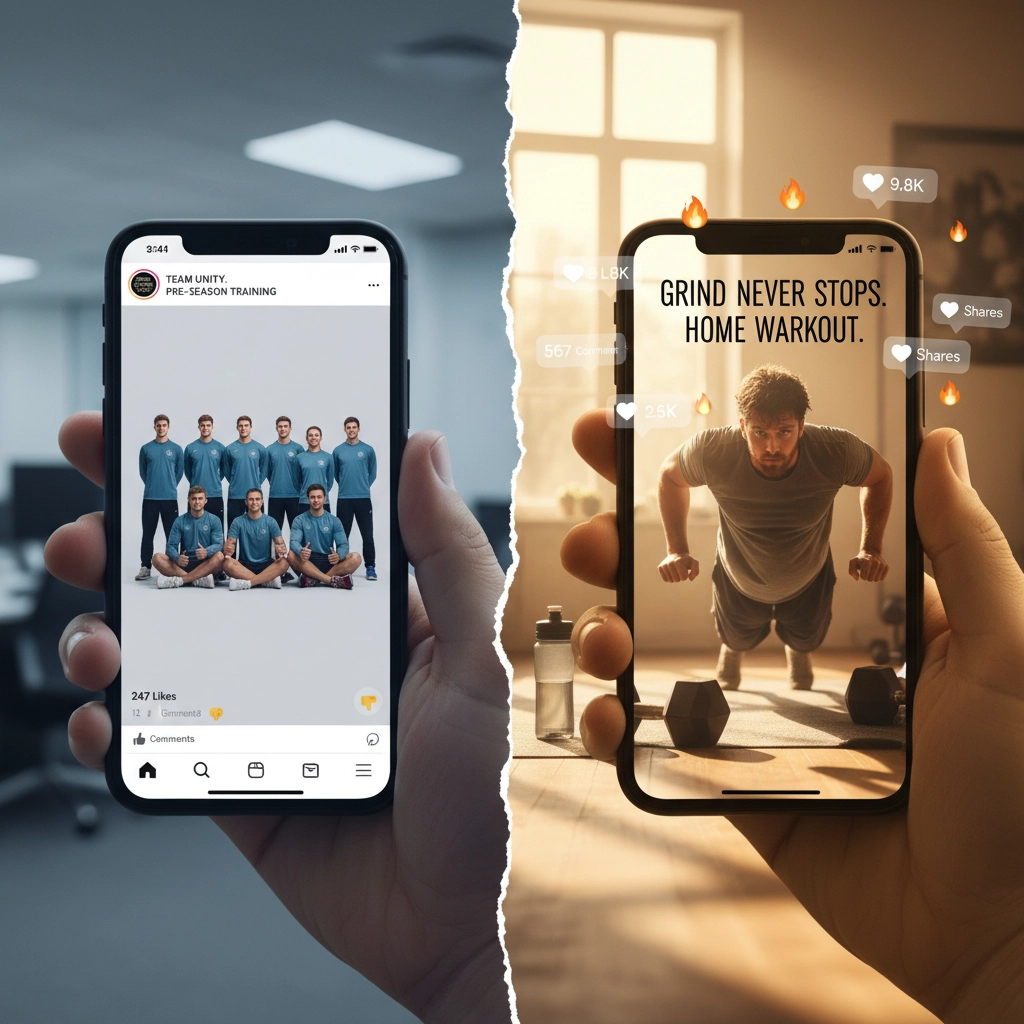Sports marketing has shifted dramatically in recent years. Traditional team-focused content no longer delivers the engagement and ROI that brands expect. The solution lies in player-generated content strategies that leverage individual athletes' personal brands and authentic connections with fans.
Teams and sports brands are discovering that content created by individual players generates significantly higher engagement rates than official team accounts. This shift represents a fundamental change in how sports marketing operates across all major social media platforms.
The Problem with Traditional Team Content
Traditional team social media accounts face numerous limitations that restrict their effectiveness. Official team posts often feel corporate and disconnected from the fan experience. These accounts must maintain a professional tone that can limit authentic engagement opportunities.
Team accounts also struggle with consistent content creation throughout the year. During off-seasons, maintaining audience engagement becomes increasingly difficult when relying solely on organizational content. The impersonal nature of team posts fails to create the emotional connections that drive fan loyalty and purchasing decisions.
Player-generated content addresses these limitations by providing authentic, personal perspectives that resonate more effectively with audiences. Individual athletes can share behind-the-scenes moments, training insights, and personal stories that team accounts cannot authentically replicate.

Understanding Player-Generated Content Value
Player-generated content offers several advantages over traditional team-focused strategies. Individual athletes possess personal brands that extend beyond their team affiliations. These personal brands create opportunities for deeper fan engagement and more diverse content creation.
Athletes can address topics and share perspectives that official team accounts cannot. Personal training routines, lifestyle content, and individual achievements provide content variety that keeps audiences engaged year-round. This content type also performs better across algorithm-driven platforms that prioritize authentic engagement.
The authentic nature of player-generated content creates trust between athletes and fans. This trust translates into higher conversion rates for brand partnerships and promotional campaigns. Fans view athlete endorsements and recommendations as more credible than traditional advertising approaches.
Hack 1: Leverage Behind-the-Scenes Training Content
Training content represents one of the most effective forms of player-generated content. Athletes can share workout routines, practice sessions, and preparation strategies that fans cannot access through official channels. This content type performs consistently well across Instagram, TikTok, and YouTube platforms.
Training content should focus on process rather than results. Fans engage more with content showing effort and preparation than with highlight reels. Athletes can share struggles, improvements, and daily routines that humanize their professional experiences.
Brands can collaborate with athletes to incorporate products naturally into training content. Equipment, nutrition, and recovery products integrate seamlessly into authentic training documentation. This approach creates more effective promotional content than traditional advertising methods.
Hack 2: Create Platform-Specific Content Strategies
Different social media platforms require distinct content approaches for optimal performance. Instagram favors high-quality visual content with strong storytelling elements. Athletes should focus on photo quality, caption depth, and strategic hashtag usage for Instagram success.
TikTok prioritizes authentic, entertaining content that leverages current trends and challenges. Athletes can participate in viral challenges while adding sports-specific elements that showcase their personalities and skills. Short-form video content performs best when it feels spontaneous and genuine.
Twitter excels at real-time engagement and conversation. Athletes should use this platform for live commentary, fan interaction, and timely responses to current events. The immediate nature of Twitter allows for authentic fan engagement that builds stronger relationships.

Hack 3: Implement Strategic Fan Interaction Techniques
Direct fan interaction significantly increases engagement rates across all platforms. Athletes should respond to comments, share fan content, and acknowledge supporters regularly. These interactions create personal connections that strengthen fan loyalty and increase content visibility.
Fan Q&A sessions provide excellent content opportunities while demonstrating accessibility. Athletes can answer questions about training, career experiences, or personal interests. This content type generates high engagement while providing valuable insights into athlete personalities.
User-generated content campaigns encourage fans to create content featuring or mentioning athletes. These campaigns expand reach organically while reducing content creation burden on athletes. Successful fan content campaigns often include hashtag strategies and prize incentives.
Hack 4: Maximize Cross-Platform Content Repurposing
Efficient content creation requires strategic repurposing across multiple platforms. A single training session can generate content for Instagram posts, Instagram Stories, TikTok videos, and Twitter updates. Each platform adaptation should optimize content for specific audience expectations and algorithm preferences.
Long-form content can be divided into multiple shorter pieces for different platforms. YouTube videos can become Instagram Reels, Twitter threads, and TikTok compilations. This approach maximizes content value while reducing creation time and effort.
Athletes should maintain consistent personal branding across platforms while adapting content formats appropriately. Visual elements, messaging themes, and personality traits should remain consistent even when content formats vary between platforms.
Hack 5: Partner with Micro-Influencers and Fan Accounts
Collaboration with smaller fan accounts and micro-influencers amplifies athlete content reach without significant costs. These partnerships often provide more authentic promotion than traditional advertising approaches. Micro-influencers typically maintain higher engagement rates than larger accounts.
Fan account partnerships can include content sharing, cross-promotion, and collaborative campaigns. These relationships benefit both parties by expanding audience reach and creating more diverse content opportunities. Fan accounts often possess deep knowledge of audience preferences and trending topics.
Strategic partnerships should focus on account alignment with athlete values and target audiences. Quality relationships with smaller accounts often generate better results than partnerships with larger but less engaged followings.

Hack 6: Optimize Content Timing and Consistency
Content scheduling significantly impacts engagement rates across all platforms. Athletes should post when their specific audiences are most active online. Platform analytics provide data about optimal posting times for individual accounts.
Consistency in posting frequency helps maintain audience engagement and algorithm favorability. Regular posting schedules create audience expectations and improve content visibility. However, quality should never be sacrificed for consistency goals.
Content batching allows athletes to create multiple pieces during dedicated time periods. This approach ensures consistent posting while accommodating training and competition schedules. Scheduling tools can automate posting while maintaining authentic engagement through real-time responses.
Hack 7: Measure and Adapt Content Performance
Data analysis enables continuous improvement in content strategy effectiveness. Athletes should track engagement rates, reach metrics, and follower growth across all platforms. This data reveals which content types and posting strategies generate the best results.
Performance tracking should focus on meaningful metrics rather than vanity numbers. Engagement rate, comment quality, and conversion metrics provide more valuable insights than follower count alone. These metrics indicate authentic audience connection and content effectiveness.
Regular strategy adjustments based on performance data ensure continued improvement and relevance. Content strategies should evolve with platform changes, audience preferences, and individual athlete development. Flexibility and adaptation are essential for long-term success.
Implementation Strategy
Successful player-generated content strategies require systematic implementation approaches. Athletes should start with one or two platforms to build competency before expanding to additional channels. This focused approach allows for quality development without overwhelming content creators.
Content planning and creation schedules help maintain consistency while accommodating athletic commitments. Athletes should allocate specific time periods for content creation and audience engagement. Professional support may be necessary for optimal results and time management.
Regular evaluation and adjustment ensure strategies remain effective as platforms and audiences evolve. The sports social media landscape changes rapidly, requiring adaptive approaches and continuous learning. Success depends on flexibility and willingness to experiment with new content approaches.
Player-generated content represents the future of sports marketing. Athletes who master these strategies will build stronger fan relationships, create more opportunities, and achieve greater success both during and after their competitive careers. The shift from team-focused to player-focused content is not just a trend but a fundamental change in how sports marketing operates.
